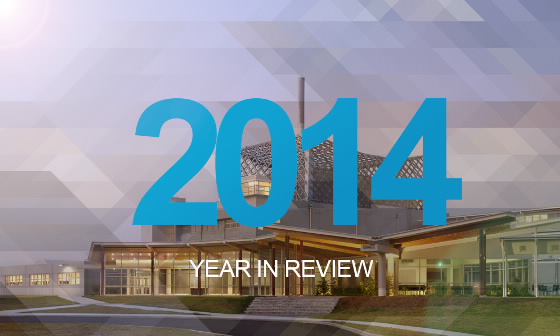Whether it was receiving awards, engaging the community or accomplishing great research achievements, 2014 was a big year for ANSTO.
One of our most popular videos this year is the Power of 10. A video that takes us on a journey from somewhere in the universe to a tiny atom found in the DNA of a flower on earth. |
Our environmental research
The year was marked by local and global demand for our research and services, as well as great collaborations and is thanks to the more than 1000 scientists, engineers and experts working at ANSTO who are helping to answer the significant environmental, medical and industrial questions using nuclear techniques. Here are some highlights.
Environmental research conducted at ANSTO has been helping to better understand our waterways and the best ways to protect them. Local politicians, school principals, citizen scientists and members of the public joined ANSTO on an expedition from Hobart to Sydney researching the impact of plastics on the marine ecosystem.
 |
The research is helping to understand the 'traceability' of plastic and the best management practices to ensure a more sustainable future. Professor Richard Banati explained the benefits of this project at TedXSydney 2014.
In the arid Pilbara region of Western Australia ANSTO’s Dr Karina Meredith led a research team to help identify groundwater resources in the area. Groundwater makes up 98% of the world's fresh water supply, but is difficult to access due to its underground location.
Given the scarce nature of surface water in places like the Pilbara, the work ANSTO has been doing is helping to locate viable alternate sources of water that benefits communities, industry and agriculture.
Other highlights:
We've kept you informed of the development of the ANSTO Nuclear Medicine (ANM) project. Now with the bulk of the excavation work finalised and the foundations laid, work is well underway on Australia’s new nuclear medicine manufacturing facility, which will enable Australia to supply 25-30% of global demand for the most common radionuclide used in nuclear medicine, Molybdenum-99.
Research published in Nature Communications by scientists from ANSTO, The University of Sydney and University of Wollongong confirmed the existence of generations of mice living without a protein considered important for life itself.
 |
The discovery was heralded as a scientific breakthrough that could be the key to the development of better diagnostics and new treatments for conditions as diverse as multiple sclerosis, dementia, cancer and obesity.
If we weren't involved in important community events including fundraising for Sutherland2Surf, Clean Up Australia Dayor hosting art projects about mind and brain health, then we were celebrating the work of women in science, including environmental researcher Suzanne Hollins, materials scientist Vanessa Peterson, and ANSTO Nuclear Medicine (ANM) Board member Sarah Ballantyne.
We also hosted a number of important dignitaries both at our research facilities, including NSW Minister for Resources and Energy, Anthony Roberts MP, the Hon. Ian Macfarlane MP, and the Minister for Industry and numerous other local and international guests; and also contributed to national efforts, including attending Australia’s recent co-hosting of the 15th Ministerial Level Meeting of the Forum for Nuclear Cooperation in Asia (FNCA).
Other notable mentions:
- Sunrise visits ANSTO
- Channel Nine’s Today show visits ANSTO
- Sydney Weekender visits ANSTO
- ANSTO researcher one of 15 young Australians to meet Nobel Laureates in Germany
- ANSTO Early Career Researchers claim international award
ANSTO joined the world in celebrating the International Year of Crystallography, which is a fundamental science studying the arrangement of atoms that make up solids and has paved the way for huge technological advances in the modern world, making our lives easier today.
A series of events have been held throughout the year culminating in Sydney with Crystals in the City educating the public on the importance of crystallography and some of the benefits a century of research has given the world. Visit our dedicated web page for more information.
Other highlights
Our most popular story was the announcement of the winner of the ANSTO Eureka Prize for Innovative Use of Technology, which this year went to the Garvan Institute of Medical Research and Australian National University for a DIY microscope that costs only $2 that can turn your smartphone into a science lab and transform field work worldwide —from medicine to biology to geoscience.
Australian and Taiwanese scientists discovered a new molecule “28copper15hydride” which puts the science community one step closer to solving one of the barriers to the development of cleaner, greener hydrogen fuel-cells as a viable power source for cars.
ANSTO’s highly skilled Radiation Technology team helped a Victorian group of innovative researchers develop a new, highly efficient method of preparing porous and reduced graphene oxide. Processes to produce porous graphene are attracting increased attention for their potential applications in sensing, energy storage, membrane separation, biological sequencing, composite materials and nano-electronics.

A new apprenticeship program is helping ANSTO to become the employer of choice in The Shire and Illawarra region encouraging highly skilled applicants of both genders to gain experience in a range of mechanical and engineering fields, as well as the fabrication and maintenance of scientific instruments at our facilities.
Want to work at ANSTO? Visit our careers page.
Published: 15/12/2014


